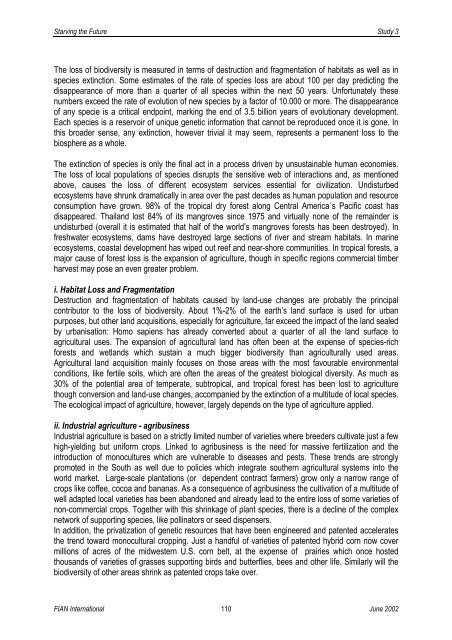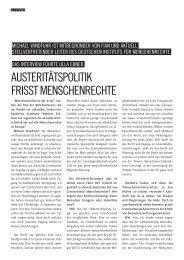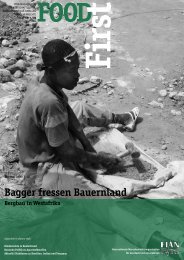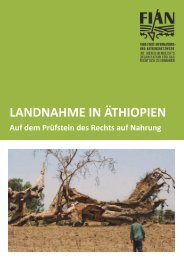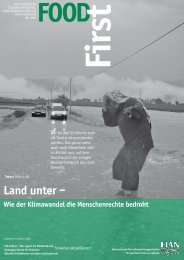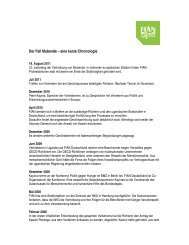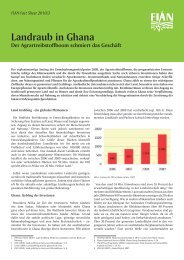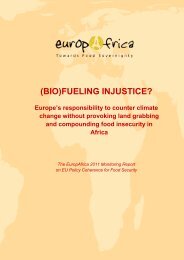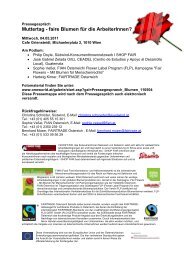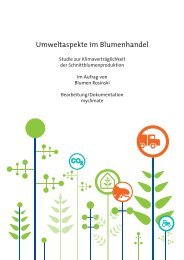Study 3: Ecodestruction and the Right to Food: The Cases of Water ...
Study 3: Ecodestruction and the Right to Food: The Cases of Water ...
Study 3: Ecodestruction and the Right to Food: The Cases of Water ...
Create successful ePaper yourself
Turn your PDF publications into a flip-book with our unique Google optimized e-Paper software.
Starving <strong>the</strong> Future <strong>Study</strong> 3<br />
<strong>The</strong> loss <strong>of</strong> biodiversity is measured in terms <strong>of</strong> destruction <strong>and</strong> fragmentation <strong>of</strong> habitats as well as in<br />
species extinction. Some estimates <strong>of</strong> <strong>the</strong> rate <strong>of</strong> species loss are about 100 per day predicting <strong>the</strong><br />
disappearance <strong>of</strong> more than a quarter <strong>of</strong> all species within <strong>the</strong> next 50 years. Unfortunately <strong>the</strong>se<br />
numbers exceed <strong>the</strong> rate <strong>of</strong> evolution <strong>of</strong> new species by a fac<strong>to</strong>r <strong>of</strong> 10.000 or more. <strong>The</strong> disappearance<br />
<strong>of</strong> any specie is a critical endpoint, marking <strong>the</strong> end <strong>of</strong> 3.5 billion years <strong>of</strong> evolutionary development.<br />
Each species is a reservoir <strong>of</strong> unique genetic information that cannot be reproduced once it is gone. In<br />
this broader sense, any extinction, however trivial it may seem, represents a permanent loss <strong>to</strong> <strong>the</strong><br />
biosphere as a whole.<br />
<strong>The</strong> extinction <strong>of</strong> species is only <strong>the</strong> final act in a process driven by unsustainable human economies.<br />
<strong>The</strong> loss <strong>of</strong> local populations <strong>of</strong> species disrupts <strong>the</strong> sensitive web <strong>of</strong> interactions <strong>and</strong>, as mentioned<br />
above, causes <strong>the</strong> loss <strong>of</strong> different ecosystem services essential for civilization. Undisturbed<br />
ecosystems have shrunk dramatically in area over <strong>the</strong> past decades as human population <strong>and</strong> resource<br />
consumption have grown. 98% <strong>of</strong> <strong>the</strong> tropical dry forest along Central America´s Pacific coast has<br />
disappeared. Thail<strong>and</strong> lost 84% <strong>of</strong> its mangroves since 1975 <strong>and</strong> virtually none <strong>of</strong> <strong>the</strong> remainder is<br />
undisturbed (overall it is estimated that half <strong>of</strong> <strong>the</strong> world’s mangroves forests has been destroyed). In<br />
freshwater ecosystems, dams have destroyed large sections <strong>of</strong> river <strong>and</strong> stream habitats. In marine<br />
ecosystems, coastal development has wiped out reef <strong>and</strong> near-shore communities. In tropical forests, a<br />
major cause <strong>of</strong> forest loss is <strong>the</strong> expansion <strong>of</strong> agriculture, though in specific regions commercial timber<br />
harvest may pose an even greater problem.<br />
i. Habitat Loss <strong>and</strong> Fragmentation<br />
Destruction <strong>and</strong> fragmentation <strong>of</strong> habitats caused by l<strong>and</strong>-use changes are probably <strong>the</strong> principal<br />
contribu<strong>to</strong>r <strong>to</strong> <strong>the</strong> loss <strong>of</strong> biodiversity. About 1%-2% <strong>of</strong> <strong>the</strong> earth’s l<strong>and</strong> surface is used for urban<br />
purposes, but o<strong>the</strong>r l<strong>and</strong> acquisitions, especially for agriculture, far exceed <strong>the</strong> impact <strong>of</strong> <strong>the</strong> l<strong>and</strong> sealed<br />
by urbanisation: Homo sapiens has already converted about a quarter <strong>of</strong> all <strong>the</strong> l<strong>and</strong> surface <strong>to</strong><br />
agricultural uses. <strong>The</strong> expansion <strong>of</strong> agricultural l<strong>and</strong> has <strong>of</strong>ten been at <strong>the</strong> expense <strong>of</strong> species-rich<br />
forests <strong>and</strong> wetl<strong>and</strong>s which sustain a much bigger biodiversity than agriculturally used areas.<br />
Agricultural l<strong>and</strong> acquisition mainly focuses on those areas with <strong>the</strong> most favourable environmental<br />
conditions, like fertile soils, which are <strong>of</strong>ten <strong>the</strong> areas <strong>of</strong> <strong>the</strong> greatest biological diversity. As much as<br />
30% <strong>of</strong> <strong>the</strong> potential area <strong>of</strong> temperate, subtropical, <strong>and</strong> tropical forest has been lost <strong>to</strong> agriculture<br />
though conversion <strong>and</strong> l<strong>and</strong>-use changes, accompanied by <strong>the</strong> extinction <strong>of</strong> a multitude <strong>of</strong> local species.<br />
<strong>The</strong> ecological impact <strong>of</strong> agriculture, however, largely depends on <strong>the</strong> type <strong>of</strong> agriculture applied.<br />
ii. Industrial agriculture - agribusiness<br />
Industrial agriculture is based on a strictly limited number <strong>of</strong> varieties where breeders cultivate just a few<br />
high-yielding but uniform crops. Linked <strong>to</strong> agribusiness is <strong>the</strong> need for massive fertilization <strong>and</strong> <strong>the</strong><br />
introduction <strong>of</strong> monocultures which are vulnerable <strong>to</strong> diseases <strong>and</strong> pests. <strong>The</strong>se trends are strongly<br />
promoted in <strong>the</strong> South as well due <strong>to</strong> policies which integrate sou<strong>the</strong>rn agricultural systems in<strong>to</strong> <strong>the</strong><br />
world market. Large-scale plantations (or dependent contract farmers) grow only a narrow range <strong>of</strong><br />
crops like c<strong>of</strong>fee, cocoa <strong>and</strong> bananas. As a consequence <strong>of</strong> agribusiness <strong>the</strong> cultivation <strong>of</strong> a multitude <strong>of</strong><br />
well adapted local varieties has been ab<strong>and</strong>oned <strong>and</strong> already lead <strong>to</strong> <strong>the</strong> entire loss <strong>of</strong> some varieties <strong>of</strong><br />
non-commercial crops. Toge<strong>the</strong>r with this shrinkage <strong>of</strong> plant species, <strong>the</strong>re is a decline <strong>of</strong> <strong>the</strong> complex<br />
network <strong>of</strong> supporting species, like pollina<strong>to</strong>rs or seed dispensers.<br />
In addition, <strong>the</strong> privatization <strong>of</strong> genetic resources that have been engineered <strong>and</strong> patented accelerates<br />
<strong>the</strong> trend <strong>to</strong>ward monocultural cropping. Just a h<strong>and</strong>ful <strong>of</strong> varieties <strong>of</strong> patented hybrid corn now cover<br />
millions <strong>of</strong> acres <strong>of</strong> <strong>the</strong> midwestern U.S. corn belt, at <strong>the</strong> expense <strong>of</strong> prairies which once hosted<br />
thous<strong>and</strong>s <strong>of</strong> varieties <strong>of</strong> grasses supporting birds <strong>and</strong> butterflies, bees <strong>and</strong> o<strong>the</strong>r life. Similarly will <strong>the</strong><br />
biodiversity <strong>of</strong> o<strong>the</strong>r areas shrink as patented crops take over.<br />
FIAN International 110<br />
June 2002


